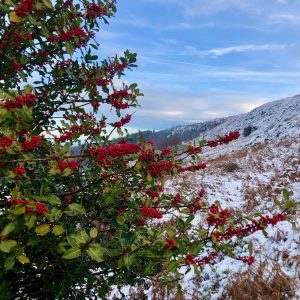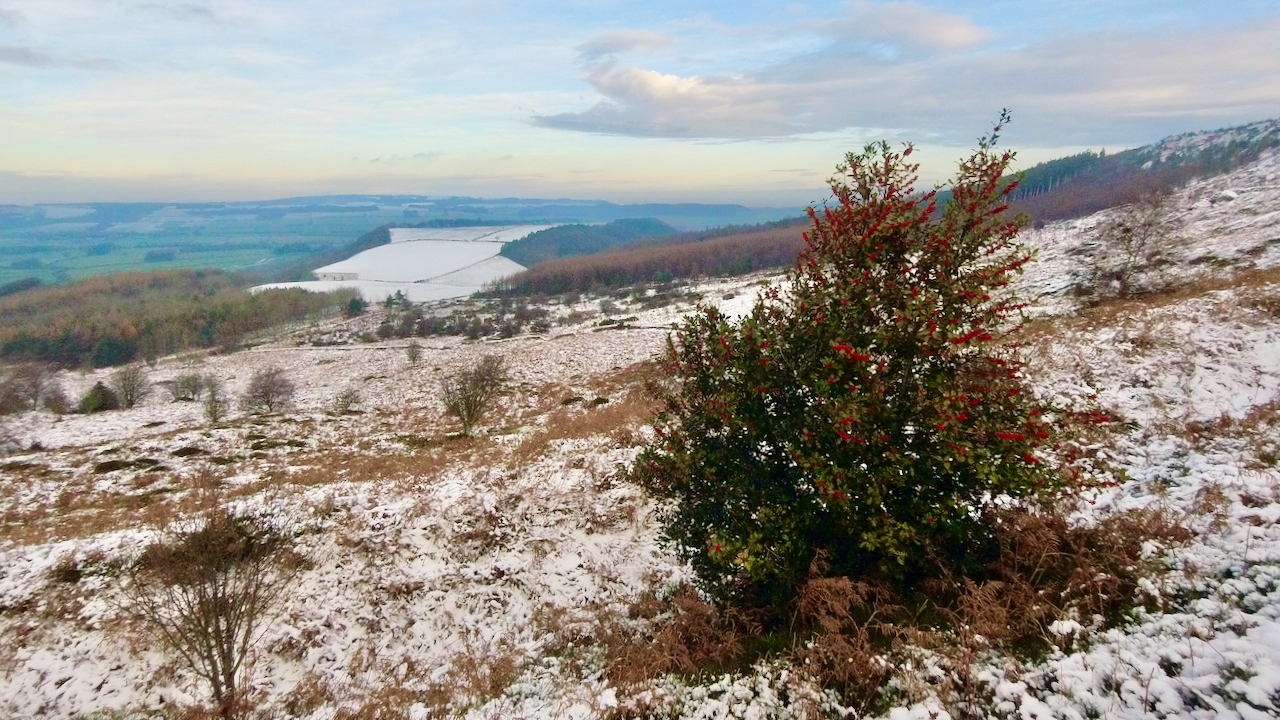It’s been a bumper year for all sorts of fruits and berries, and the holly is no exception.
I was fascinated by this holly bush on Ryston Bank — the northern slope of Little Roseberry. Its branches are laden with bright red berries. In the distance is the flat topped Bousdale Hill with its fields of snow.
While we may not deck our halls with broughs of holly any more, perhaps just sticking up a sprig or two, the bush’s use as festive decorations date back to both the Druids and the Romans. “At such times the ancient Britons decorated the interior of their huts, and the Romans, during their Saturnalia, adorned both their temples and private dwellings with [holly] as an offering to the gods. The Briton, however, so embellished the interior of his rude hut so that the sylvan spirits, by reason of the storms and frosts being driven from the woods, might find congenial shelter under something of a similar condition of things to the woods themselves.“1Blakeborough, Richard. ‘Notes on North Riding Lore. Trees and Plants. | Northern Weekly Gazette | Saturday 26 September 1903 | British Newspaper Archive’. 2022. Britishnewspaperarchive.co.uk <https://www.britishnewspaperarchive.co.uk/viewer/bl/0003075/19030926/079/0010> [accessed 9 December 2022]
So hang your sprig of holly in your halls, and spread yuletide cheer. But remember, beneath its greens and reds there might be hiding a spirit of the woods.

Holly trees are either male or female, with only the female producing berries. A bumper crop of berries was said to foretell a harsh winter2Mabey, Richard. “Flora Britannica”. Page 245. Reed International Books Ltd. 1996. ISBN 1 85619 377 2..
Notice the leaves on this holly bush have few spines if any. This is due to them being above the grazing height of marauding deer — sheep and cattle haven’t been on Roseberry Common for years. Holly develops its prickles as a defense against such grazing3Gooley, Tristan. The Walker’s Guide to Outdoor Clues and Signs. Page 51. Hodder & Stoughton. 2014.. Holly, in fact, has the highest calorific value of any tree browsed by animals and is full of nutrients4Mabey, Richard. “Flora Britannica”. Page 246. Reed International Books Ltd. 1996. ISBN 1 85619 377 2.. It was much used as cattle fodder up to the 18th-century.
- 1Blakeborough, Richard. ‘Notes on North Riding Lore. Trees and Plants. | Northern Weekly Gazette | Saturday 26 September 1903 | British Newspaper Archive’. 2022. Britishnewspaperarchive.co.uk <https://www.britishnewspaperarchive.co.uk/viewer/bl/0003075/19030926/079/0010> [accessed 9 December 2022]
- 2Mabey, Richard. “Flora Britannica”. Page 245. Reed International Books Ltd. 1996. ISBN 1 85619 377 2.
- 3Gooley, Tristan. The Walker’s Guide to Outdoor Clues and Signs. Page 51. Hodder & Stoughton. 2014.
- 4Mabey, Richard. “Flora Britannica”. Page 246. Reed International Books Ltd. 1996. ISBN 1 85619 377 2.

Leave a Reply